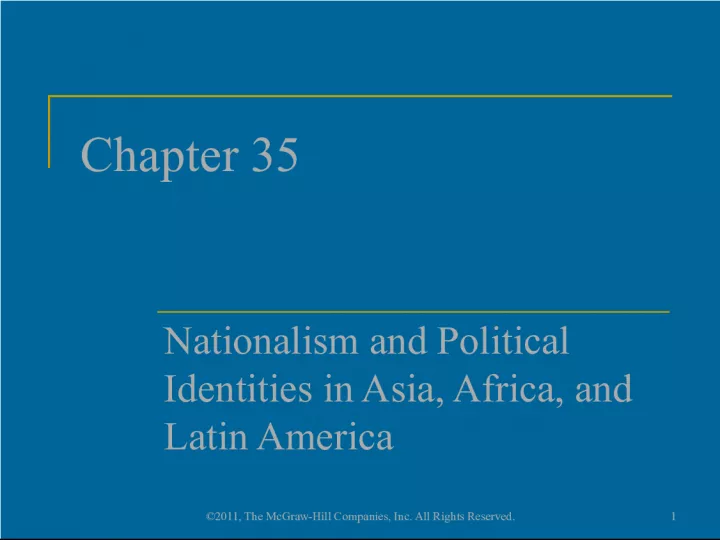Nationalism and Political Identities in Asia, Africa, and Latin America: India's Quest for Home Rule


This chapter discusses the history of India's struggle for self-rule through the Indian National Congress, founded in 1885.
- Uploaded on | 1 Views
-
 tejaswi
tejaswi
About Nationalism and Political Identities in Asia, Africa, and Latin America: India's Quest for Home Rule
PowerPoint presentation about 'Nationalism and Political Identities in Asia, Africa, and Latin America: India's Quest for Home Rule'. This presentation describes the topic on This chapter discusses the history of India's struggle for self-rule through the Indian National Congress, founded in 1885.. The key topics included in this slideshow are . Download this presentation absolutely free.
Presentation Transcript
Slide1Chapter 35Nationalism and Political Identities in Asia, Africa, and Latin America 1 ©2011, The McGraw-Hill Companies, Inc. All Rights Reserved.
Slide2India’s Quest for Home Rule Indian National Congress founded 1885, to promote self-rule Initial support from both Hindus and Muslims Original position in favor of collaboration with British, after World War I moved to opposition British encouraged development of Muslim League (1906) to blunt Congress Woodrow Wilson, Lenin inspirations to movement ©2011, The McGraw-Hill Companies, Inc. All Rights Reserved. 2
Slide3Mohandas K. Gandhi (1869-1948) Hindu, studied law in London, practiced in South Africa Opposed apartheid Returned to India 1915, made Indian National Congress into a mass movement Titled Mahatma : “great soul” Opposed caste system 3 ©2011, The McGraw-Hill Companies, Inc. All Rights Reserved.
Slide4Gandhi4 ©2011, The McGraw-Hill Companies, Inc. All Rights Reserved.
Slide5Gandhi’s Passive Resistance Ahimsa: nonviolence Satyagraha: passive resistance (“truth and firmness”) Non-Cooperation Movement (1920-1922) Civil Disobedience Movement (1930) Boycott of British institutions Amritsar Massacre (1919) 5 ©2011, The McGraw-Hill Companies, Inc. All Rights Reserved.
Slide6The Government of India Act (1937) Creation of autonomous legislature 600 nominally sovereign princes refuse to cooperate Muslim fears of Hindu dominance Traditional economic divide Especially severe with Great Depression Muhammad Ali Jinnah (1876-1948) proposes partition, creation of the state of Pakistan 6 ©2011, The McGraw-Hill Companies, Inc. All Rights Reserved.
Slide7The Republic of China Revolution in 1911 forces Emperor Puyi to abdicate Sun Yatsen (1866-1925) proclaims Republic of China in 1912 Political anarchy follows Independent warlords exercise local control 7 ©2011, The McGraw-Hill Companies, Inc. All Rights Reserved.
Slide8Chinese Nationalism May Fourth Movement Students, urban intellectuals protest foreign interference Especially Japanese interference Marxism increases in popularity Chinese Communist Party founded in Shanghai (1921) Leader: Mao Zedong (1893-1976) 8 ©2011, The McGraw-Hill Companies, Inc. All Rights Reserved.
Slide9Sun Yatsen (1866-1925) Created Nationalist People’s Party ( Guomindang ) Accepts support from Soviet Union Members of the Chinese Communist Party also join Guomindang 9 ©2011, The McGraw-Hill Companies, Inc. All Rights Reserved.
Slide10Civil War Jiang Jieshi (Chiang Kai-Shek, 1887-1975) takes over after death of Sun Yatsen Launches military expedition to unify China, turns against communist allies Communists flee 6,215 miles to northwest China, 1934: the Long March Mao Zedong leads, elucidates Chinese communism (Maoism) 10 ©2011, The McGraw-Hill Companies, Inc. All Rights Reserved.
Slide11The Struggle for Control in China,1927-1936 ©2011, The McGraw-Hill Companies, Inc. All Rights Reserved. 11
Slide12Imperialist Japan Japan signs treaties under League of Nations to limit imperialist activity, 1922-1928 Political chaos in interwar Japan, assassinations Militarist, imperialist circles advocate greater assertion of Japanese power in the region China a soft target ©2011, The McGraw-Hill Companies, Inc. All Rights Reserved. 12
Slide13The Mukden Incident (1931) Japanese troops in Manchuria, China, secretly blow up small parts of the Japanese-built South Manchuria Railway as pretext for war Over opposition of Japanese civilian government, military takes Manchuria, renames it Manchukuo, a puppet state League of Nations censures Japan; Japan leaves the League of Nations 13 ©2011, The McGraw-Hill Companies, Inc. All Rights Reserved.
Slide14Africa and the Great War African colonies participate in World War I Allies invade German-controlled colonies Africans encouraged to fight white soldiers Many Europeans left to be deployed elsewhere Encouraged local rebellions and challenges to European domination 14 ©2011, The McGraw-Hill Companies, Inc. All Rights Reserved.
Slide15Africa’s New Elite Postwar class of elite Often influenced by education, other experiences abroad Jomo Kenyatta (1895-1978), Kenyan nationalist Moved to create modern nation-states in Africa Pan-Africanism promoted by Marcus Garvey (Jamaica, 1887-1940) “Back to Africa” 15 ©2011, The McGraw-Hill Companies, Inc. All Rights Reserved.
Slide16Latin American Developments Reaction against U.S. influence; protests by university students Explore alternate political ideologies, especially Marxism Fidel Castro (Cuba, 1926- ) José Carlos Mariátegui (Peru, 1895-1930) Artist Diego Rivera (Mexico, 1886-1957) 16 ©2011, The McGraw-Hill Companies, Inc. All Rights Reserved.
Slide17Fidel Castro (1926- )17 ©2011, The McGraw-Hill Companies, Inc. All Rights Reserved.
Slide18United States Economic Domination Great War ensures U.S. domination Huge capital investment in Latin America; export of raw materials U.S. economic neocolonialism under President William Howard Taft (1857-1931) “Dollar diplomacy” “Yankee imperialism” 18 ©2011, The McGraw-Hill Companies, Inc. All Rights Reserved.
Slide19The United States in Latin America,1895-1941 ©2011, The McGraw-Hill Companies, Inc. All Rights Reserved. 19
Slide20The “Good Neighbor Policy” Franklin Delano Roosevelt (1882-1945) Avoids direct intervention by supporting local leaders U.S. Marines train local militias ©2011, The McGraw-Hill Companies, Inc. All Rights Reserved. 20
Slide21FDR21 ©2011, The McGraw-Hill Companies, Inc. All Rights Reserved.
Slide22Nicaraguan Developments Civil war in Nicaragua, 1920s U.S. supports Anastacio Somoza Garcia (1896- 1956) Augusto César Sandino leads opposition to U.S. influence Somoza assassinates Sandino in 1934 Maintains good relations with U.S. 22 ©2011, The McGraw-Hill Companies, Inc. All Rights Reserved.
Slide23Mexican Developments Roosevelt formally renounces intervention as per Monroe Doctrine, 1933 Lázaro Cárdenas (1895-1970) nationalizes Mexican oil industry in 1938 Previously controlled by U.S., British interests Roosevelt convinces U.S., British businesses to accept $24 million in compensation ($260 sought) U.S. wants to retain support of Mexico with approaching war Also, increasing dependence on Mexican immigrant labor ©2011, The McGraw-Hill Companies, Inc. All Rights Reserved. 23